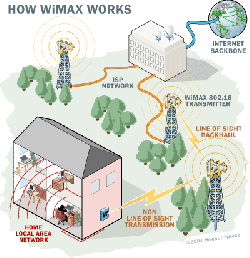WiMAX
From Computing and Software Wiki
| Line 20: | Line 20: | ||
== Technical Information == | == Technical Information == | ||
| + | [[Image:Wimax-diagram.gif|thumb|250px|right| How WiMAX works.[3]]] | ||
| + | |||
===Comparison with Wi-Fi=== | ===Comparison with Wi-Fi=== | ||
| Line 57: | Line 59: | ||
# [http://www.ieee802.org/16/tge/ IEEE 802.16e Task Group (Mobile WirelessMAN®)]. ieee802.org. | # [http://www.ieee802.org/16/tge/ IEEE 802.16e Task Group (Mobile WirelessMAN®)]. ieee802.org. | ||
# [http://www.ieee802.org/16/tgd/ IEEE 802.16 Task Group d]. ieee802.org. | # [http://www.ieee802.org/16/tgd/ IEEE 802.16 Task Group d]. ieee802.org. | ||
| + | # [http://www.techwarelabs.com/articles/other/wimax_wifi/ WiMAX vs WiFi] | ||
== External links == | == External links == | ||
Revision as of 21:14, 13 April 2008
WiMAX, the Worldwide Interoperability for Microwave Access, enables the delivery of wireless broadband services over long distances. WiMAX is based upon the IEEE 802.16 standard, also called WirelessMAN, which was developed for non-line-of-sight (LoS) communication. WiMAX technology can provide connectivity in many ways, from point-to-point links to full mobile cellular type communication. The name WiMAX was created by the WiMAX forum which was formed in June 2001.The WiMAX forum describes WiMAX as "a standards-based technology enabling the delivery of last mile wireless broadband access as an alternative to cable and DSL." WiMAX technology has already been incorporated into notebook computers and PDAs to deliver high speed mobile Internet services.
Contents |
Uses
High speed bandwidth and wireless connectivity make WiMAX suitable for the following potential applications:
- Connecting Wi-Fi hotspots with each other and to other parts of the Internet.
- Providing a wireless alternative to cable and DSL for last mile broadband access.
- Providing high-speed data and telecommunications services.
- Providing a diverse source of Internet connectivity as part of a business continuity plan. That is, if a business has a fixed and a wireless Internet connection, especially from unrelated providers, they are unlikely to be affected by the same service outage.
Broadband access
Many companies are examining and testing WiMAX technology for “last mile” connectivity at high data rates. The resulting competition with cable and DSL providers may bring lower prices for home and business users where internet connectivity was economically unavailable.
"WiMAX access was used to assist with communications in Aceh, Indonesia, after the tsunami in December 2004. All communication infrastructure in the area, other than Ham Radio, was destroyed, making the survivors unable to communicate with people outside the disaster area and vice versa. WiMAX provided broadband access that helped regenerate communication to and from Aceh."[1]
Mobile handset applications
Cellular companies are evaluation WiMAX technology to increases mobile bandwidth for a variety of data-intensive applications.
Sprint Nextel – Announced investment of about US$ 5 billion in WiMAX technology over the next few years[2]. WiMAX networks will go live for a test launch in Chicago, Baltimore, and Washington DC. Commercial lauches are still expected to happen during spring of 2008.[3]
Technical Information
Comparison with Wi-Fi
Standards
Current WiMAX technology called Mobile WiMAX, is based on the IEEE Std 802.16e-2005[1]. This IEEE standard is an amendment of IEEE Std 802.16-2004[2], which means the actual standard is 802.16-2004 as amended by 802.16e-2005. Both standards need to be read together to understand them fully. IEEE Std 802.16-2004 addresses only fixed systems. It replaced IEEE Standards 802.16-2001, 802.16c-2002, and 802.16a-2003.
IEEE 802.16e-2005
IEEE amendments taken directly from http://en.wikipedia.org/wiki/WiMAX#IEEE_802.16e-2005
IEEE 802.16e-2005 improves upon IEEE 802.16-2004 by:
- Adding support for mobility (soft and hard handover between base stations). This is seen as one of the most important aspects of 802.16e-2005, and is the very basis of 'Mobile WiMAX'.
- Scaling of the Fast Fourier Transform (FFT) to the channel bandwidth in order to keep the carrier spacing constant across different channel bandwidths (typically 1.25 MHz, 5 MHz, 10 MHz or 20 MHz). Constant carrier spacing results in a higher spectrum efficiency in wide channels, and a cost reduction in narrow channels. Also known as Scalable OFDMA (SOFDMA). Other bands not multiples of 1.25 MHz are defined in the standard, but because the allowed FFT subcarrier numbers are only 128, 512, 1024 and 2048, other frequency bands will not have exactly the same carrier spacing, which might not be optimal for implementations.
- Improving NLOS coverage by utilizing advanced antenna diversity schemes, and hybrid-Automatic Retransmission Request (HARQ)
- Improving capacity and coverage by introducing Adaptive Antenna Systems (AAS) and Multiple Input Multiple Output (MIMO) technology
- Increasing system gain by use of denser sub-channelization, thereby improving indoor penetration
- Introducing high-performance coding techniques such as Turbo Coding and Low-Density Parity Check (LDPC), enhancing security and NLOS performance
- Introducing downlink sub-channelization, allowing administrators to trade coverage for capacity or vice versa
- Enhanced Fast Fourier Transform algorithm can tolerate larger delay spreads, increasing resistance to multipath interference
- Adding an extra QoS class (enhanced real-time Polling Service) more appropriate for VoIP applications.
802.16d vendors point out that fixed WiMAX offers the benefit of available commercial products and implementations optimized for fixed access. It is a popular standard among alternative service providers and operators in developing areas due to its low cost of deployment and advanced performance in a fixed environment. Fixed WiMAX is also seen as a potential standard for backhaul of wireless base stations such as cellular, Wi-Fi or even Mobile WiMAX.
Future development
Current deployments
The WiMAX Forum now lists over 350 WiMAX trials and deployments. Current and planned deployments and the bands in which they operate and the standards they use are listed in the article below.
List of deployed WiMAX networks
See also
Wireless Network Security
Network-Based Software Architectures
References
- IEEE 802.16e Task Group (Mobile WirelessMAN®). ieee802.org.
- IEEE 802.16 Task Group d. ieee802.org.
- WiMAX vs WiFi
External links
- WiMAX Day: An on-line journal of WiMAX news and information
- WiMAX Forum
- WiMAX on Wikipedia.com
Goedvola 14:23, 13 April 2008 (EDT)

